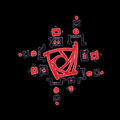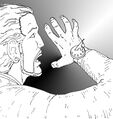Template:Selected anniversaries/February 17: Difference between revisions
No edit summary |
No edit summary |
||
| Line 28: | Line 28: | ||
||1888: Otto Stern born ... scientist and winner of the Nobel Prize for Physics in 1943 for his development of the molecular beam as a tool for studying the characteristics of molecules and for his measurement of the magnetic moment of the proton. Pic. | ||1888: Otto Stern born ... scientist and winner of the Nobel Prize for Physics in 1943 for his development of the molecular beam as a tool for studying the characteristics of molecules and for his measurement of the magnetic moment of the proton. Pic. | ||
||1890: Ronald Fisher born ... statistician, biologist, and geneticist. | ||1890: Ronald Fisher born ... statistician, biologist, and geneticist ... "a genius who almost single-handedly created the foundations for modern statistical science" and "the single most important figure in 20th century statistics". In genetics, his work used mathematics to combine Mendelian genetics and natural selection; this contributed to the revival of Darwinism in the early 20th-century revision of the theory of evolution known as the modern synthesis. For his contributions to biology, Fisher has been called "the greatest of Darwin’s successors". Pic. | ||
||1890: Christopher Latham Sholes dies ... inventor who invented the QWERTY keyboard, and along with Frank Haven Hall, Samuel W. Soule, Carlos Glidden and John Pratt, has been contended as one of the inventors of the first typewriter in the United States. | ||1890: Christopher Latham Sholes dies ... inventor who invented the QWERTY keyboard, and along with Frank Haven Hall, Samuel W. Soule, Carlos Glidden and John Pratt, has been contended as one of the inventors of the first typewriter in the United States. | ||
| Line 38: | Line 38: | ||
||1905: Rózsa Péter born ... mathematician and logician. She is best known as the "founding mother of recursion theory". Pic. | ||1905: Rózsa Péter born ... mathematician and logician. She is best known as the "founding mother of recursion theory". Pic. | ||
||1906: Henrik Selberg born ... mathematician. He was born in Bergen as the son of Ole Michael Ludvigsen Selberg and Anna Kristina Brigtsdatter Skeie. He was a brother of Sigmund, Arne and Atle Selberg. He was appointed professor at the University of Oslo from 1962 to 1973. He is best known for his works on complex functions and potential theory. | ||1906: Henrik Selberg born ... mathematician. He was born in Bergen as the son of Ole Michael Ludvigsen Selberg and Anna Kristina Brigtsdatter Skeie. He was a brother of Sigmund, Arne and Atle Selberg. He was appointed professor at the University of Oslo from 1962 to 1973. He is best known for his works on complex functions and potential theory. Pic search no: https://www.google.com/search?q=Henrik+Selberg+mathematician | ||
||1907: Alfred Brousseau born ... educator, photographer and mathematician and was known mostly as a founder of the Fibonacci Association and as an educator. Pic: http://faculty.evansville.edu/ck6/bstud/brousseau.html | ||1907: Alfred Brousseau born ... educator, photographer and mathematician and was known mostly as a founder of the Fibonacci Association and as an educator. Pic: http://faculty.evansville.edu/ck6/bstud/brousseau.html | ||
Revision as of 05:26, 18 September 2019
882: Physician, astronomer, mathematician, and crime-fighter Thābit ibn Qurra publishes new theory of Gnomon algorithm functions with applications in detecting and preventing crimes against mathematical constants.
1600: Dominican friar, philosopher, mathematician, poet, and cosmological theorist Giordano Bruno is burned at the stake.
1863: Confederate submarine H. L. Hunley engages and sinks the Union warship USS Housatonic. This is the first known instance of a submarine engaging and sinking a warship.
1864: Mathematician and crime-fighter Marius Sophus Lie publishes new theory of continuous symmetry with applications in the detection and prevention of crimes against mathematical constants.
1891: Mathematician Abraham Fraenkel born. He will contribute to axiomatic set theory, and publish a biography of Georg Cantor.
2003: George Plimpton publishes first in prize-winning series of articles on high-energy literature.
2012: Mathematician and theorist Nicolaas Govert de Bruijn dies. He made contributions in the fields of analysis, number theory, combinatorics, and logic.
2016: Steganographic analysis of Pinwheel Diagram unexpectedly reveals "between four and five hundred kilobytes" of previously unknown Gnomon algorithm functions.
2018: Steganographic analysis of The Eel Discovers Time Travel reveals five hundred gigabytes of encrypted data.








